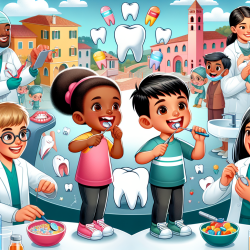Introduction
In the realm of special education and therapy, understanding the diverse needs of children with cleft lip and palate is crucial. Recent research conducted in Northern Italy provides valuable insights into the oral health-related quality of life (OHRQoL) for children with these conditions, emphasizing the importance of both children's and caregivers' perspectives. This blog post explores how practitioners can leverage these findings to enhance their skills and improve the well-being of children with cleft conditions.
Understanding the Research
The study titled "Influence of Cleft Lip and Palate on Oral Health-Related Quality of Life in Northern Italy: Exploring Both the Children’s and Caregivers’ Perspectives" examined the perceptions of OHRQoL among children with cleft conditions and their caregivers. Using the Child Oral Health Impact Profile (COHIP) questionnaire, the research highlighted discrepancies between children's and caregivers' perceptions, particularly in areas such as peer interaction and functional well-being.
Key Findings
- Caregivers often perceive a lower OHRQoL for their children compared to the children's self-reports.
- Significant differences were noted in perceptions of peer interaction and functional well-being.
- Factors such as cleft type, gender, and parents' country of origin influenced the level of agreement between children and caregivers.
Implications for Practitioners
For practitioners working with children with cleft conditions, these findings underscore the importance of considering both the child's and the caregiver's perspectives. Here are some strategies to enhance practice:
- Utilize Comprehensive Assessments: Incorporate both child and caregiver assessments to gain a holistic understanding of the child's OHRQoL.
- Facilitate Open Communication: Encourage dialogue between children and caregivers to bridge perception gaps and foster mutual understanding.
- Tailor Interventions: Design interventions that address specific areas of concern, such as peer interaction and functional well-being, based on individual assessments.
- Promote Cultural Sensitivity: Recognize the influence of cultural factors on perceptions and tailor support accordingly.
Encouraging Further Research
While this study provides valuable insights, it also highlights the need for further research. Practitioners are encouraged to explore the long-term effects of cleft conditions on OHRQoL and investigate interventions that can effectively address identified challenges. Collaborative research efforts can lead to more comprehensive care strategies and improved outcomes for children with cleft conditions.
Conclusion
By embracing the diverse perspectives of children and caregivers, practitioners can enhance the oral health-related quality of life for children with cleft conditions. Implementing research findings into practice not only improves individual care but also contributes to the broader understanding of cleft conditions and their impact on quality of life.
To read the original research paper, please follow this link: Influence of Cleft Lip and Palate on Oral Health-Related Quality of Life in Northern Italy: Exploring Both the Children’s and Caregivers’ Perspectives.










